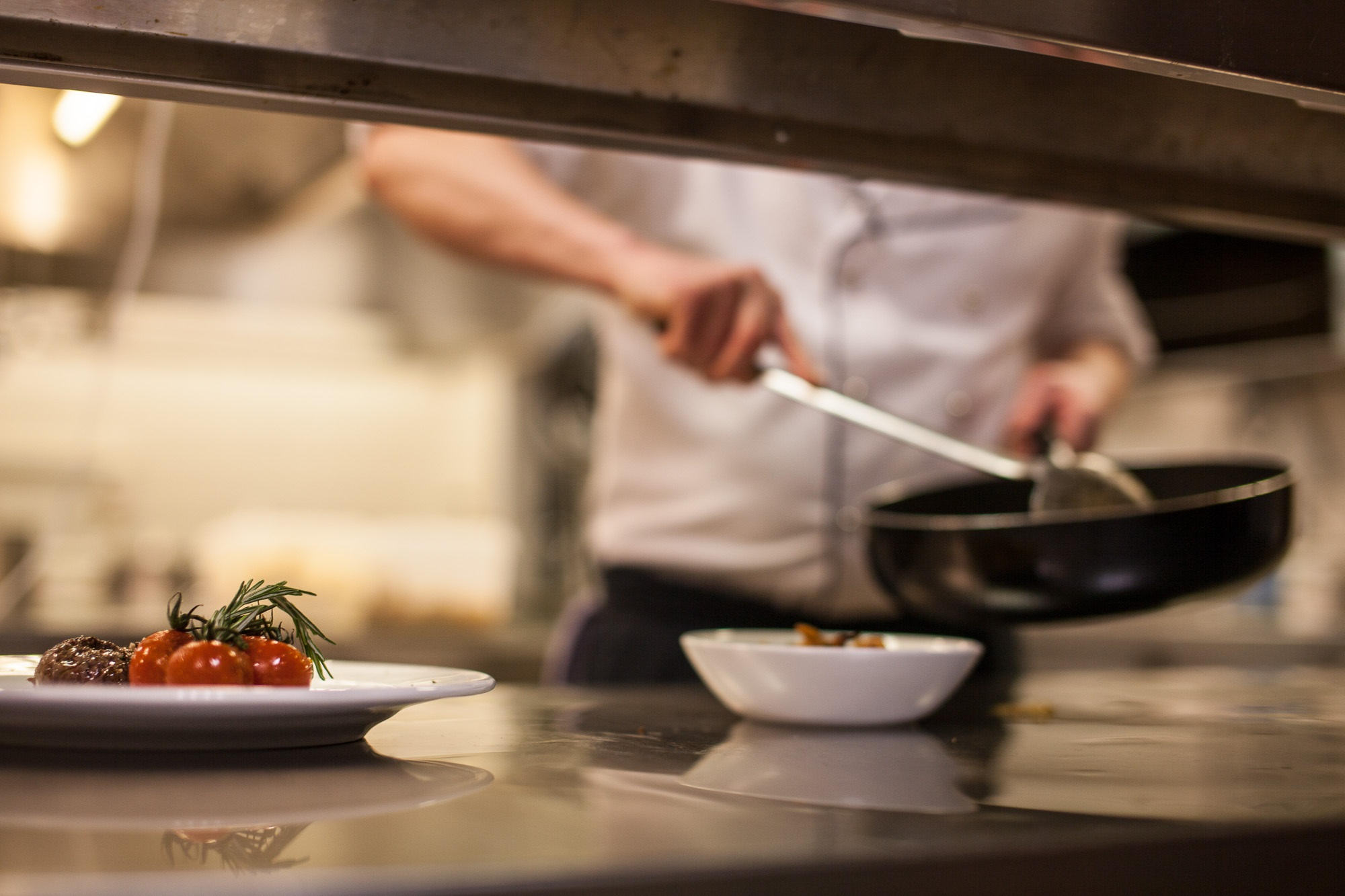Cook with olive oil
Olive oil, and it’s already a topic, is the basis of Mediterranean cuisine, together with bread and wine.
In Mallorca there is not a single dish that does not require olive oil in its preparation. To make a list of cooking recipes with olive oil, would mean to list all the dishes we know, and it would not make much sense.
That is why we only propose old recipes from Mallorcan cuisine expressed in the same words that were used at the time.
1. SOPES ESCALDADES
In the book “L’olivera” (The Olive Tree), Andreu Estarellas Pascual,from Bunyola, tells us in the year 1952 that the plate which is more eaten in the countryside and also in the capital, especially for dinner, are the Mallorcan Soups. Cooking instructions:
“Ingredients to make it: olive oil, onion, garlic, parsley, tomato, chard, cauliflower, spinach, spring onions, leek and asparagus .Place the pan over the heat with the corresponding oil – it is better to sin by excess than by default – then add the onion, garlic, parsley and tomato. When it is well cooked, that is to say, when the tomato has melted and the onion is golden, add the water with the amount of one plate of water for every plate of soup (the bread). The vegetables should already be chopped, the cabbage will be the first to be placed into the pot and when it begins to boil, then add the spinach and/or chard previously cleaned two or three times in water, also add the cauliflower. Place the bread in the dishes and when the vegetables are fully cooked, add them to the dishes covering the bread.
Indispensable conditions for the perfect soups are that the bread is wheat (brown bread) and the oil contains no acid.
When in season, wild mushrooms are put in the pan along with the other mentioned ingredients. They make the dish even better.”
2. SARDINES IN OIL
From the book “The conventual kitchen in Mallorca”, published in Palma in 2005, we reproduce this recipe from the convent of Santa Magdalena in Palma, regular canons of Sant Agustí, explained by Sor Margalida Riutort, born in Petra in 1927:
“We remove the head and guts of the sardines without opening them. Clean well in clear water. Boil in water with salt and a glass of vinegar for an hour. Allow to cool and put them in a container covered with olive oil.”
3. RABBIT WITH ONION
From the book “El ayer y el día de la cocina mallorquina” by Miquel Ferrà i Martorell, published in Palma in 1992, talks about “Emigration Gastronomy”:
“Our nineteenth century is characterised by migratory movement. The people from Soller go to France and Puerto Rico, Belgium and Mexico … The emigrants of Valldemossa usually leave for Uruguay … Those of Andratx go to Cuba and the Philippines. Those of S’Arracó to France. Those of Calvià to Buenos Aires. Those of Artà to Puerto Rico. Those from Bunyola to France and Switzerland. The ones from Palma go to Algeria. And to Algeria there are also many emigrants from different towns, the mountains or the Pla. And all this takes place between 1860 and 1920. Here, the “Indians” who return rich or who carry enough fortune to see them through their old age, raise houses and palaces, most of them in the style “Belle Epoque” or modernist. And coming from outside of Mallorca, bringing a bit of culture from other countries and more than usual, introduce many recipes into Majorca that will bring us closer to international cuisine. ”
A recipe “from a grandmother who reached a hundred years” of age:
“INGREDIENTS: A chopped rabbit, two chopped onions, a tomato, three garlic cloves, a sprig of parsley, half a spoon of cinnamon and half a spoon of black pepper, salt to taste, clove and olive oil.
PREPARATION: Fry the rabbit with olive oil in a sauce pan and then add water. Fry the onion well chopped with tomato, garlic and parsley. Then mix the rabbit and sauce in the saucepan and season with salt, pepper, cinnamon and, if desired, a little bit of clove. Once it is cooked, serve hot.”
4. OIL BISCUITS
Lluis Ripoll published, in the second half of the twentieth century, a handful of Mallorcan cookbooks. From the “book of Mallorcan sweet dishes” published in Palma in 1973, we reproduce this recipe, which he describes as Cookies or Biscuits, not exactly sweet:
“1 cup of olive oil.
1 cup of water.
That is, equal amounts of water and oil.
A little salt and enough flour that is absorbed by the mixture of water and oil (it should not reach 1 kilo) and bread yeast (approx 200 gr.)
THE WAY TO MAKE IT:
Mix the water and the oil together, add the flour, salt and yeast.
Mix all the ingredients together to obtain the dough.
Leave to ferment .
Form shape of biscuits required and then place in the oven.”
5. FRIED TENDER BEANS
In the book “Memòria gastronòmica de Mallorca” published in Palma in 2004, Aina Marroig Vives, from Caimari, born in Escorca in 1920, tells us that this recipe was prepared by the charcoal burners who worked all summer in the Mossa estate.
“Once the pods were clean, without threads and tails, they were cut into pieces of two-centimetres and slightly skewed. They were placed in a pan or cauldron with olive oil, with no other ingredients except several garlic cloves cut into thin slices. When the beans were almost ready, a few bunches of chives or spring onions were added and left to simmer. Later a botifarró cut into squares and a piece of shredded sobrassada were added, using the part which was stuck to the skin of the sausage. It was seasoned to taste and served. The dish was accompanied, occasionally, with beaten eggs that were poured into the pan before removing the beans; in this way a very appetising scrambled version was prepared with all the ingredients.”
6. FRIED VEGETABLES WITH SCRAMBLED EGGS
In the book “Memòria gastronòmica de Mallorca” published in Palma in 2004, Maria Font Barceló, from Vilafranca, who lived in the Hortella orchard, in Sant Joan, tells us that, when there was no meat , but there were varied vegetables available, they could prepare a dish that today we would call vegetarian, all prepared with products from the orchard.
“A pan was prepared containing olive oil and thinly sliced potatoes; another pan was prepared with oil and eggplants cut into slices and green and red peppers cut in irregular pieces; a few cloves of garlic, salt and pepper were added. When this mixture became tender and practically cooked, the fried potatoes and the scrambled eggs were added to the pan or cauldron containing the other ingredients. They continued stirring this mixture of ingredients until the egg was well cooked.”
7. COD WITH SAUCE
Pereta Joan Canyelles, Madò Pereta de Sa Font, from Marratxinet, born in 1908, explains in the “Memòria gastronòmica de Mallorca” published in Palma in 2004, a very tasty way to prepare cod, which is even more appetising with the sauce.
“Once I had desalted the cod (left for at least one day in water which was changed from time to time), I would drain it, batter it with flour, fry in olive oil, and then leave it to one side on a plate. Using the same cod oil I would prepare the sauce with some crushed garlic, a bay leaf, a good bunch of spring onions (well cut and the more the better), finely chopped chard leaves and a lot of peeled, chopped tomatoes. Very little salt was added and when the sauce was almost cooked a bit of sweet paprika was also added. Then it was placed over the cod and better if you leave it for a few minutes in the oven to confit it.”
8. DRIED TOMATOES
From the book “The convent kitchen in Mallorca” published in Palma in 2005, we find this simple recipe from the Dominican nuns of Santa Catalina de Siena.
“Cut in half, they were dried by placing on hurdles that lay in the sun, and then were stored in containers, covered with olive oil. They used to be the typical garnish which accompanied fish.”
9. EGGPLANT CAKE
In the book “The convent kitchen in Mallorca, published in Palma in 2005, the Dominican nuns of Santa Catalina de Siena explain how to prepare it.
“Peel four kilos of eggplant and cut into squares, mash together two kilograms of white onion and boiled ham. Mix all the ingredients and cook in a pan with olive oil, garlic, cinnamon and sweet paprika and leave it to cook slowly. In a greased mold, which will go in to the oven, place half of the mixture and on top, a layer of finely cut slices of camallot. We add the rest of the mixture and on top pour three beaten eggs. It turns out to be much tastier if it’s cold.”
10. CRESPELLS
It is a sweet pastry, eaten typically in Mallorca during Easter. The name comes from the Latin “crispus” – curly. This recipe was transmitted to us by Catalina Gayà Mayol, born in Sant Joan in 1912.
“Ingredients: 1 kilo of flour, 400 grams of lard, 400 grams of sugar, 4 egg yolks, 1 cup of olive oil, 1 cup of dry white wine, grated lemon and cinnamon.
Once the dough is prepared, cover the table with flour and prepare balls that are then flattened with the roller; once the crespells are shaped with molds, usually round with notches or other fun shapes, they are baked in the oven. Once they have cooled, sprinkle them with powdered sugar.”
11. FISH MARINADE
Mestre Tomeu Esteva, in his book “The Mallorcan Cuisine” teaches us how to prepare a good pickled fish.
“Ingredients for 6 people: 1,300 grams of fish (llampuga, red mullet, thun …), 3 dl. of olive oil, 2 dl. of vinegar, 2 dl. of white wine, 1 dl. of water, 1 medium sliced onion , 1 carrot cut into thin strands, some shoots of parsley, 4 clean artichokes, slice the bottoms, 4 bay leaves, 4 thin slices of lemon, 8 cloves of garlic, salt and a pinch of paprika .
Clean the fish, salt it and lightly cover with flour. Fry in olive oil and place in a clay pot. Drain, trying not to dry and place the slices of lemon on top of the fish. In the remaining oil, cook the garlic for a few seconds, add the vegetables and let sweat over a low heat. Add the red paprika and then moisture with the vinegar, wine and water. Simmer a few minutes over a low heat.
Remove from the heat and allow to cool, and then pour over the fish. The pickle liquid should cover all the fish. Leave for several days before consuming.”
12SPINY LOBSTER MALLORCA STYLE
Mestre Tomeu Esteva explains in his book “The Mallorcan Cuisine” how to prepare a dish of spiny lobster in the traditional Majorcan way, not as popular as the Menorcan stew, but just as tasty.
“Ingredients per person: 400 grams of spiny lobster, 1 large onion, 200 grams of tomatoes, 2 cloves of garlic, olive oil, salt, pepper and paprika.
Chop the spiny lobster, fry it in olive oil and add the finely chopped onion, the tomato and the sliced garlic, salt and pepper. Once fried, add a little bit of water and let simmer- taking into account the weight of the lobster- until the water is reduced. Serve in a very hot clay pot.”




